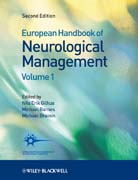
European handbook of neurological management v. 1
Gilhus, Nils Erik
Barnes, Michael R.
Brainin, Michael
Evidence-based, peer reviewed, best practice management guidelines for neurologists Diagnosis is only part of the puzzle. Effective treatment is what your patients really want. The European Federation of Neurological Societies has been publishing management guidelines in the European Journal of Neurology for many years. Developed by a consensus approach, using graded evidence, and then fully peer reviewed, these guidelines provide gold-standard, best-practice guidance to the treatment of neurological disorders. They help bridge the gap between what is done and what should be done for patients with neurological disorders. The basic guidelines have been expanded with 'Recommendations' based on strong evidence and 'Good Practice Points' where only weaker evidence is available. The Guidelines in this volume cover: Investigation Major neurological diseases Neuromuscular diseases Infections Neurological problems Sleep disordersRehabilitation The European Handbook of Neurological Management provides a thoroughly rounded and grounded approach to best-practice neurological management using evidence-based principles. INDICE: Introduction. 1 Routine cerebrospinal fluid (CSF) analysis (F. Deisenhammer). 2 Use of imaging in cerebrovascular disease (J. C. Masdeua). 3 Useof imaging in multiple sclerosis (M. Filippi). 4 Neurophysiological tests andneuroimaging procedures in non-acute headache (G. Sandrini). 5 Use of anti-interferon beta antibody measurements in multiple sclerosis (P. Soelberg SOrensen). 6 Use of antibody testing in nervous system disorders (H. J. Willison). 7 The Use of Skin Biopsy in the Diagnosis of Small Fiber Neuropathy (G. Lauria).8 Assessment of Neuropathic Pain (G. Cruccu). 9 Aute stroke (W. Hacke). 10 Drug Treatment of Migraine.(Stefan Evers). 11 Cluster headache and other trigemino-autonomic cephalgias (Stefan Evers). 12 Diagnosis and treatment of primary (idiopathic) dystonia (Alberto Albanese). 13 Mild traumatic brain injury 14 Early (uncomplicated) Parkinsons disease (Wolfgang H. Oertel). 15 Late (complicated) Parkinsons disease (Wolfgang H. Oertel). 16 Alzheimer's (Waldemar G.). 17Post-polio syndrome(E. Farbu). 18 Autoimmune neuromuscular conduction disorders (G.O. Skeie). 19 Chronic inflammatory demyelinating polyradiculoneuropathy (Peter Y.K. Van den Bergh). 20 Multifocal motor neuropathy (Ivo N. van Schaik). 21 Paraproteinaemic demyelinating neuropathy (Robert DM Hadden). 22 Limb Girdle Muscular Dystrophies (Bushby K.). 23 Neurological complications of HIV infection (P. Portegies). 24 Viral Meningo-Encephalitis: A Review of Diagnostic Methods and Guidelines for Management (I. Steiner). 25 Treatment of neuropathicpain (N. Attal). 26 Acute relapses of multiple sclerosis (F. Sellebjerg). 27 Status epilepticus (H. Meierkord). 28 Alcohol-related seizures then G. 29 Brain metastases (R. Soffietti). 30 Paraneoplastic neurological syndromes (C.A. Vedeler). 31 Nystagmus and oscillopsia (A. Straube). 32Orthostatic Hypotension (Lahrmann H.). 33 Cerebral Venous and Sinus Thrombosis (Karl Einhäupl). 34 Cerebral vasculitis (N.J. Scolding). 35 Neurological problems in liver transplantation (A. Stracciaria). 36 Fatty acid mitochondrial disorders (C. Angelin). 37 Management of narcolepsy in adults (M. Billiard). 38 Sleep disorders in neurodegenerative disorders and stroke (P. Jennum). 39 Restless Legs Syndrome and Periodic Limb Movement Disorder (Dr García-Borreguero). Cognitive rehabilitation(S.F. Cappa). Index.
- ISBN: 978-1-4051-8533-2
- Editorial: Wiley-Blackwell
- Encuadernacion: Cartoné
- Páginas: 584
- Fecha Publicación: 15/10/2010
- Nº Volúmenes: 1
- Idioma: Inglés
